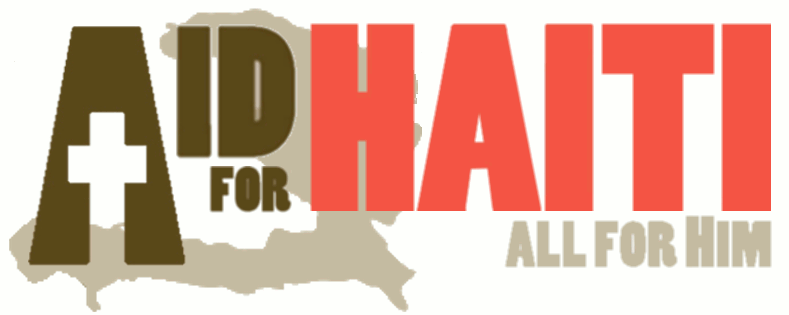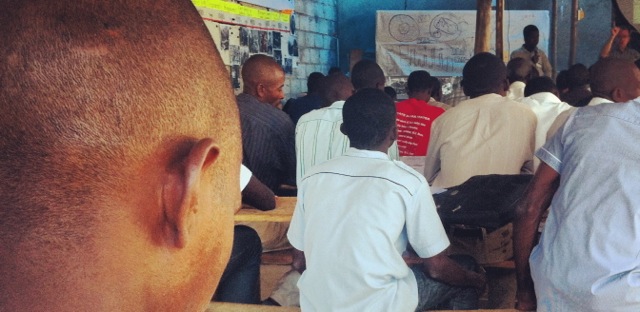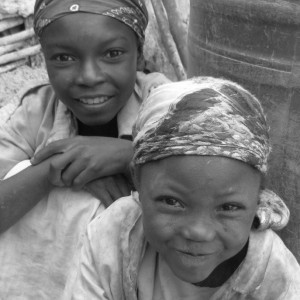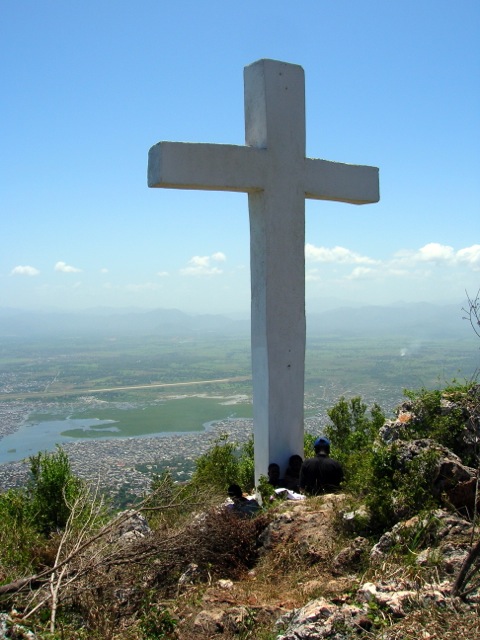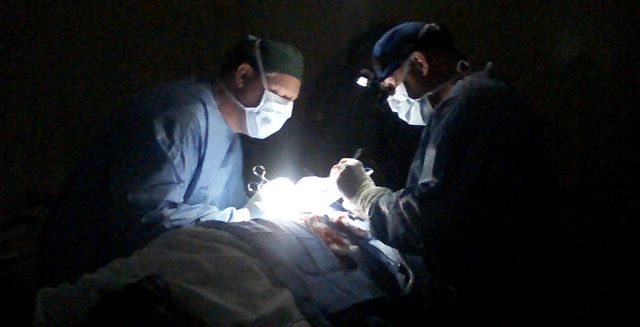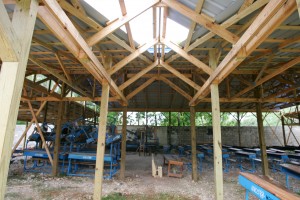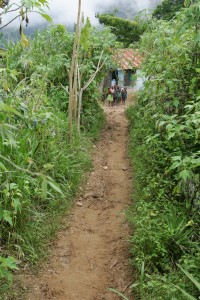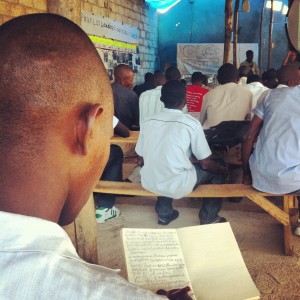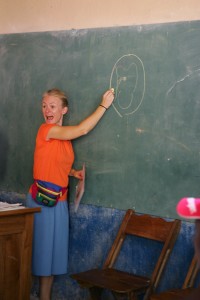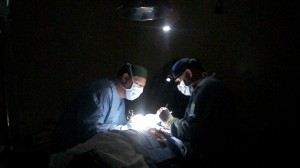On the 22nd of October, Michael and I flew into Haiti and headed directly into the mountains after picking up the bags we left here. We drove for 5-6 hours till we came to the end of the vehicle road way up in the mountains behind Port Au Prince. We had traversed a paved road with 200+ curves, a riverbed that took around 4 hours and 20+ river crossings, and a dirt road along the mountain side so steep at places you wonder how you can drive on it. At the end of the road we unloaded the 36 buckets that contain our clinic, the luggage the team needed for staying in the mountains for 5 days, and all the food we would eat during that time. Yes, it was quite a load, and sometimes I get embarrassed at how much stuff we can come up with. But we don’t want to be a burden to the community, so we take our sleeping mats and all the food we need. Anyway, the Haitian’s from the mountain we were going to, all chose what they could carry and headed off. By the time the time the trucks were empty, it was 5. The last group of us started off on the 2-3 hour hike with three rivers to cross and hour of daylight. We ended up hiking in the dark, the last half of the way, which I don’t really mind. Everything went well, we all arrived safely, had some supper and went to bed. Tuesday I set up the pharmacy while the sheets were being hung to form consultation rooms. We had 4 consultation rooms, and soon got rolling. There was the normal aches and pains, gas and acid, and quite a few clogged ears. I had some good help in the pharmacy and we had fun giving out packages with hygiene items and a dress to all the girls under the age 14. CAM had quite a few donated, and it was so special to see a little girls eyes light up when she realized that this “kado” was for her! Wednesday we had around 120 people and the wind was blowing pretty hard by the evening. We knew there was a tropical storm coming, but what could we do about it? Wednesday was my birthday, what an odd place and time to turn 25 – on top of a mountain in a brewing hurricane! I thought it was fine, I love the work here and the people of Haiti. By Thursday it was raining and blowing, and not many people came. Friday was a full-blown hurricane and every one stayed inside. It was an adventure to go to the outhouse, the wind would rip the door out of your hands. The wind eventually did rip off the doors, oh well, it is all in a mountain trip. We got cabin bound and passed the time singing and playing games of Dictionary and Pictionary and Confusion. We made that church on the mountain ring with song after song, most from memory. I was so glad that the team consisted of people who love to sing. We had no electric, and no lamps or candles; when darkness fell, we had only our flashlights. One evening we played with hand shadows, and the doctor was really good with making his shadow talk! We always went to bed early, what else is there to do? The next morning we woke up to RAIN and WIND again. At various times and places you could find someone (a lot of the time it was me) staring out into the storm. I was SO grateful we were on top of the mountain top instead of in the valley. If I have visual elbow room, I don’t mind not being able to go somewhere nearly as much. Saturday was the day the team was to have flown out, but we weren’t going anywhere. The hurricane had lingered over our particular spot in Haiti as if wanting to wash us into the ocean. Finally the thing moved on, but to our dismay and blank amazement, part of it broke off the main storm and sat directly above us, dumping the rain! Now you have to realize that we couldn’t just leave when the rain stopped. We were trapped by the rivers, one on each side of the mountain, roaring and foaming so loud you could hear it at the top. Saturday the rain basically stopped and were we ever GLAD to see the sun. We started trying to find a way out as it would be days before the river went down enough to get to the trucks, to say nothing of the big river going down enough to drive out through. We actually called the UN and other various organizations to see if we could get a helicopter to come get the team out, but we finally were told that there were only two helicopters in Haiti. They were both occupied doing rescue operations in life threatening situations, and our situation wasn’t life threatening. There were some of our team who HAD to get home, even if they had to walk out. So early Sunday morning one of our Haitian translators set out to a mountain top that was six miles away, as the crow flies. That mountain top was accessible by vehicles. He finally got to his destination around four in the afternoon, and by that time most of the team decided they wanted to hike out. Michael volunteered to go as escort, and with a few Haitians for guides and three mules, they set out. They left around 2 in the afternoon, and hiked till 10:30 pm. They stayed in the house of the mayor for that region, and finished the hike the next morning in 45 min. A man from CAM picked up the team, and Michael hiked all the way back to Patmos. He was so tired and footsore when he got back. We did clinic a few more days, and five days after we were supposed to have left, we finally packed up to head out. Horror of horrors, it started clouding up and thundering the afternoon before we were to leave. We couldn’t just head out, we needed people to carry out the stuff, and they wouldn’t come before morning. Thank God, He made the clouds dissipate, and there wasn’t a drop of rain! At 4:30 the next morning, the Pastor with us started hollering on the microphone he had brought along, calling the people of the mountains to come and help us get out. They showed up one at a time till we left around 7 am.
We hiked out Wednesday morning, the 31st, and it was such a beautiful day! After 30+ inches of rain, all the dust and loose dirt was washed away, leaving all the colors bright and clean. Of course the trees and plants were wind battered, but the air and earth were so clean and bright. I saw colors in the rocks that I never thought existed there, great streaks of red rock that were normally covered in dusty dirty brown. I fancied that those big red streaks were where a dinosaur was squashed in the flood and fossilized! Not really, but it was something to laugh about! We loaded up the trucks and headed out, Jeriah and Michael driving. They have both driven over everything that is passable with a vehicle (and some that weren’t), so I wasn’t nervous about the trip out. A couple of the others were nervous- to a degree! We had had men fix the two washed out places in the road to the riverbed, and the one place was so steep that I could not see the hood of the truck (I was standing in the bed, right behind the cab). It was interesting to say the least. We arrived at the river, and there it was roaring away through a long S shape, fairly deep, and very bouldery. I know that is not a word, but “rocky” doesn’t describe it. We had hired 6 men to come with us and walk ahead of the trucks, clearing boulders away and making a place to drive. We had to cross the S part four times in two or three hundred yards, and each crossing was difficult. The first one, just needed rocks moved. The second was deeper, and had even bigger rocks. I’m really surprised that the men were able to keep their feet while rolling rocks away! The first truck roared through the water, but the second got hung very firmly on a rock. There was no going anywhere. The water was up to the bottom of the doors, so you can imagine how it was with a whole bunch of men trying to push the truck off the rock. It didn’t work. We finally backed up the other truck and try to pull it off. No go. So we backed up farther, and pushed it bumper to bumper, yay! This time it worked! But oh no! now the first truck spun out, it’s wheels just sinking into the loose gravel of the river bottom. All the men got behind and pushed, and out it went, towing along the second truck too. That was only the second crossing. The third wasn’t so bad, but the second truck again spun out in a gravel bed and had to be pulled out. All this time, we had been crossing the river pretty much straight across, but the fourth time was a DEEP narrower spot. No driving straight across this one! Before each of these crossings, the men all stood at the edge surveying the area and talking over the best place to try. They finally decided to drive with the flow for a short way, and gunning the engines both trucks pulled safely out the other side. The rest of the way, was talked over, cleared, crossed, and repeated more times than I remember. The water kept getting deeper little by little, till we were hearing reports of it being muddy and deeper and uncross-able close to Jacmel. We reached the road Michael hiked up over the mountain, and decided to try getting out that way and not risk being stopped by the river father down. The road was steep, and it had a few places to fix before we could proceed, but we finally made it to the top. It was SO wonderful to finally be on the top of another mountain looking back over the swollen river. The rest of the trip was uneventful as far as Haiti traveling goes.
And that dear friends, concludes my tale. Here are some pictures that hopefully are like the proverbial “thousand words”!
Exam rooms right, pharmacy left, sleeping rooms up front
See the donkey’s tail, the trees and the tarp? That takes some wind!
Kind of dreary…
Beautiful sunshine!
Full moon behind the highest mountain in Haiti.
The sunsets were gorgeous!
This is where I couldn’t see the hood of the truck.
Clearing away the boulders
Stuck on a rock
This place was deep and swift
The water was getting deeper
Looking back to where we came from!
